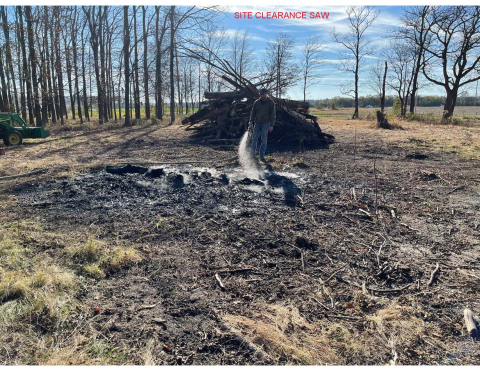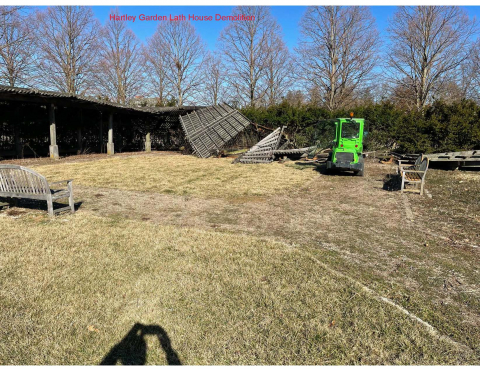You are here
- Home
- Foundations for Cultivating Indigenous Gardens within the Southern Arboretum Woodlands
Foundations for Cultivating Indigenous Gardens within the Southern Arboretum Woodlands
Project Description
Restoration of the Southern Arboretum Woodlands (SAW) has benefitted from two previous SSC grants. The initial grant provided funding for removal of a dense understory of honeysuckle and other invasive species. The current grant focused on selective harvesting of trees, some of which are being milled to produce various lumber grade products. Along the way, prairie patches and understory native shrubs are being established and work continues on suppression of invasive species. This project is designed to build upon the current state of the SAW restoration and introduce elements of Indigenous gardens within the SAW and other selected locations within the Arboretum. Tribal partners will provide advice and guidance through all phases of the project. Vice Chancellor Rand will serve as the liaison with Tribal partners. The plant assemblages will include exemplars of those traditionally used by Indigenous people for food, fibre, fuel, construction, and medicinal purposes. The assemblages will be located to match soil hydrology which trends from moderately well- to poorly-drained from east to west across the site and shade tolerance as influenced by canopy light penetration, which is patchy. Education/Outreach/Research is an important element of the project and will showcase Indigenous gardening as a model for sustainable land management. Providing a service to Tribal partners in the recovery, preservation, and production of Native Knowledges related to plants, language, and cultural practices is a central project goal. We are optimistic that this initiative will build bridges between campus and Native communities and foster opportunities for other ventures that respect and learn from Indigenous knowledge.
The project will be located within the grounds of the Arboretum. The Southern Arboretum Woodlands will be the principal focus. Other locations, such as the Hartley Collections Garden, will be considered for Indigenous demonstration gardens featuring native plant assemblages for outreach programs. Kevin McSweeney is the Arboretum Director and responsible for activities on site. He will consult as needed with campus, F&S and ACES colleagues, Ameren, and City of Urbana as specific needs arise. For example, Ameren has already been consulted about tree trimming along their utility right-of-way.
The Prairie Band Potawatomi, as represented by council member Raphael Wahwassuk, and Associate Vice Chancellor Jacki Rand have reached a tentative agreement to create a partnership around the Indigenous Garden project. They are planning meetings for summer 2023 to introduce the project to the Tribal government and their specialists and to work out the parameters of the project. We anticipate that other Tribal entities will become engaged in the project as the initiative gathers momentum.
Faculty and students in a variety of departments have already expressed interest in the project including those in American Indian Studies, History, Natural Resources and Environmental Sciences along with colleagues in the Illinois Natural History Survey. We anticipate that broader campus engagement will ensue as the project matures.
The Arboretum staff operates a large chipper and chain saws (purchased from funds provided by The Departments of NRES and Crop Sciences) during volunteer work-days. UIUC South Farms and the Turf Research Center provide additional support in terms of expertise and short-term equipment loans (grain trucks for hauling wood chips etc.). The Arboretum purchased with funds ($65,000) from the Offices of the Provost and the ACES Dean, an Avant Loader, which is an articulated vehicle designed to work with a variety of specialized attachments (e.g., forks, bucket, tree shear, winch). This vehicle with appropriate attachments will be a key tool for thinning of the woodlands, which is an important component of the proposed project. A private donor has provided funds for purchase of a log grabber ($10,000) for the Avant loader which will appreciably improve the efficiency and safety of tree felling operations and transportation/storage of logs. The donor also provided funds ($20,000) for purchase of a small utility vehicle that is dedicated for work in the SAW.
On-going partial capture of carbon stored in a 55+ year-old wooded area via salvage and reuse of lumber for sustainable building projects. Reuse of other woody debris for mulch. Establishment of new plantings to enhance biomass and soil capture of carbon dioxide. Improved and diversified ecosystem services via new plantings creating multistoried canopy architecture with expectation of improved habitat for animal, plant, and microbial communities. Anticipated enhancement of ecosystem services includes improved landscape hydrology, soil structure and reduction in soil erosion; more diverse, seasonally varied, and abundant food sources (fruits and berries) and pollen sources (flowering trees and shrubs) for fauna; richer and more diverse substrates/habitats for microorganisms, insects and small mammals and reptiles. Aesthetic improvement of the project area through transformation of the area towards a deciduous woodland with savanna openings and imbedded Indigenous gardens. It is anticipated that through documentation of the transformation process, lessons will be learnt that will serve as guide and a stimulus for improving ecosystem services in similar degraded woodlands in other urban and suburban areas of east central Illinois.
The project is not designed as a classic restoration in which an attempt is made to recreate a representation of a prior native ecosystem. The site history and modifications to the surrounding landscape (e.g. drainage, urbanization) frustrate an attempt to recreate a wet grading to mesic prairie, the likely precursor native ecosystem to its subsequent tile drained modification for agriculture. The site’s more recent history as a site for experimental research forestry plots adds further complexity to conceiving what might be a ‘native’ ecosystem. Our approach is to remodel the landscape through removal of undesirable species, protection of desirable species and introduction of management practices and new species that will enhance biodiversity and other ecosystem services. As such our project is a novel experiment in landscape remodeling that will test the feasibility of improving important ecosystem services and functions including pollinator habitat and services; habitat for other insects, fungi, lichen, birds, small mammals, etc.; soil and biomass carbon storage; and optimal water infiltration and storage.
We anticipate that volunteer efforts along with class related projects will assist Arboretum staff in long term management of the area. In addition, we will aggressively seek grants and private funding to enhance the utility of the area for education/outreach, applied research and recreation.
No description has been provided yet.
Funding Details


SSC Basic Info
Associated iCAP Objective(s)
SSC Project Team
Project Lead:
Financial Advisor:
Team Members:
- Jacki Rand
- Michael Ward
- Jamie Ellis
- Joel Armas
- Vijay Shah
Project Application
 Foundations for Cultivating Indigenous Gardens within the Southern Arboretum Woodlands Step 1 Application
Foundations for Cultivating Indigenous Gardens within the Southern Arboretum Woodlands Step 1 Application Foundations for Cultivating Indigenous Gardens within the Southern Arboretum Woodlands Step 2 Application
Foundations for Cultivating Indigenous Gardens within the Southern Arboretum Woodlands Step 2 Application Foundations for Cultivating Indigenous Gardens within the Southern Arboretum Woodlands Step 2 Application Budget
Foundations for Cultivating Indigenous Gardens within the Southern Arboretum Woodlands Step 2 Application Budget
Project Award Letter
Project Semester Report
 Spring 2025 Cultivating Indigenous Gardens within the Southern Arboretum Woodlands Semester Report
Spring 2025 Cultivating Indigenous Gardens within the Southern Arboretum Woodlands Semester Report Winter/Spring 2024 Cultivating Indigenous Gardens within the Southern Arboretum Woodlands Semester Report
Winter/Spring 2024 Cultivating Indigenous Gardens within the Southern Arboretum Woodlands Semester Report Winter/Spring 2024 Cultivating Indigenous Gardens within the Southern Arboretum Woodlands Semester Report
Winter/Spring 2024 Cultivating Indigenous Gardens within the Southern Arboretum Woodlands Semester Report Fall 2023 Cultivating Indigenous Gardens within the Southern Arboretum Woodlands Semester Report Budget
Fall 2023 Cultivating Indigenous Gardens within the Southern Arboretum Woodlands Semester Report Budget Fall 2023 Cultivating Indigenous Gardens within the Southern Arboretum Woodlands Semester Report
Fall 2023 Cultivating Indigenous Gardens within the Southern Arboretum Woodlands Semester Report

